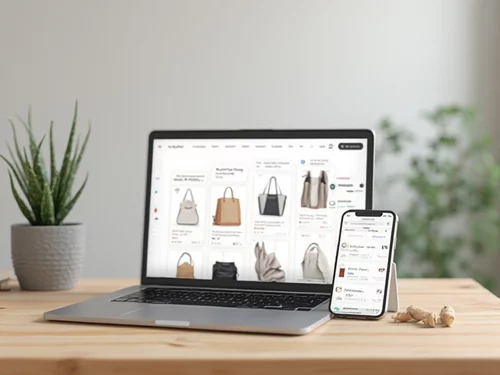Every day, the online shopping experience moves closer to the palm of our hands. Are you prepared to meet your customers where they are? A mobile-first design isn't just a benefit; it's a necessity for thriving in today's e-commerce landscape.
What You Will Learn
- The importance of mobile-first design in enhancing user experience and boosting sales.
- Key benefits include improved search engine rankings and reduced cart abandonment.
- Essential features for mobile design, such as fast load times and touch-friendly navigation.
- Actionable steps to implement mobile-first strategies to meet evolving customer needs.
- Tools and resources for tracking mobile user behavior to refine your e-commerce approach.
The Power of Mobile-First E-Commerce Design
This visual highlights the essential elements and impacts of a mobile-first e-commerce strategy, revealing how it drives conversions and improves user experience.
Why Mobile-First is Essential
- ✓ Increased Accessibility
- ✓ Better Search Rankings
- ✓ Higher Conversion Rates
Key Features for Conversions
- ★ Fast Load Times
- ★ Touch-Friendly Navigation
- ★ Clear Calls to Action (CTAs)
Impact on Conversion Rates
+160%
Conversion Rate Increase (Research)
- ↑ Enhanced User Experience
- ↓ Reduced Bounce Rates
- ↑ Improved Customer Satisfaction
Core Implementation Steps
- 1. User Research
- 2. Responsive Design
- 3. Touch-Friendly Interfaces
- 4. Optimize Site Performance
- 5. Clear Visual Hierarchies
Understanding the Importance of Mobile-First E-Commerce Design
In today's digital landscape, optimizing your online store for mobile devices is not just a trend—it's a necessity! With more consumers shopping on their smartphones, understanding the significance of mobile-first e-commerce design has never been more critical. As an e-commerce strategist, I can’t stress enough how a mobile-first approach can set your online business apart from the competition.
By prioritizing mobile design, you’re not only enhancing the user experience but also aligning with current browsing habits. After all, most Australians now prefer to shop on their mobile devices, making it essential for businesses to adapt. Let’s explore why mobile-first design is essential for e-commerce success!
Why Mobile-First is Essential for E-Commerce Success
Mobile-first design starts from the premise that your website should be built for smaller screens first, ensuring a seamless experience across all devices. This approach offers several benefits:
- Increased Accessibility: Your store becomes accessible to a broader audience who may solely use mobile devices to shop.
- Better Ranking on Search Engines: Google favors mobile-friendly websites, which can improve your search rankings.
- Higher Conversion Rates: A well-optimized mobile site leads to a smoother checkout experience, reducing cart abandonment.
As I work with various Australian entrepreneurs at Build My Online Store, it’s clear that prioritizing mobile design directly impacts sales. It’s about meeting customers where they are and making their shopping journey as easy as possible! For a deeper dive into the importance of this approach, consider this insightful article on why mobile-first design is important.
Key Features of Mobile-First Design that Drive Conversions
When designing a mobile-first e-commerce site, specific features can significantly influence your conversion rates. Here are some must-have elements:
- Fast Load Times: Mobile users expect instant access to information. Delays can lead to frustration and lost sales.
- Touch-Friendly Navigation: Ensure buttons and links are easy to click, accommodating users’ fingers rather than a mouse. For more guidance on e-commerce usability, refer to this review of usability guidelines for e-commerce website design.
- Clear Calls to Action (CTAs): Prominent and persuasive CTAs guide users through the purchasing process seamlessly.
Incorporating these features into your mobile design will not only attract more visitors but also keep them engaged, increasing the likelihood of conversion!
How Mobile Optimization Impacts Conversion Rates
The impact of mobile optimization on conversion rates is profound. Research shows that optimized mobile experiences can increase conversion rates by up to 160%! Think about it: if your site is slow and clunky on a smartphone, potential customers will simply leave. The Baymard Institute's research on mCommerce usability further highlights common issues and solutions to avoid cart abandonment.
To put things into perspective, here are a few ways mobile optimization can influence conversion:
- Enhanced User Experience: A site that’s easy to navigate and loads quickly encourages users to explore more.
- Reduced Bounce Rates: If users find what they need quickly, they’re less likely to leave your site immediately.
- Improved Customer Satisfaction: Happy customers are returning customers! A mobile-friendly site fosters satisfaction and loyalty.
As we continue to witness a shift towards mobile commerce, adapting your online store with a mobile-first design isn't just a smart move—it's essential for sustaining growth and success.
Pro Tip
To truly elevate your mobile-first e-commerce design, focus on user testing. Gather a group of real users to navigate your site on different mobile devices. Their feedback can unveil critical insights about usability and areas for improvement that you might overlook. Remember, the better the user experience, the higher your conversion rates!
Frequently Asked Questions About Mobile-First E-Commerce Design
Here are some common questions regarding mobile-first e-commerce design:
- Q: What is mobile-first e-commerce design?
- A: Mobile-first e-commerce design is an approach where you prioritize designing your website for mobile devices before adapting it for larger screens like desktops. This ensures an optimal experience for the majority of online shoppers who use smartphones.
- Q: Why is mobile-first design crucial for e-commerce success?
- A: It's crucial because a significant portion of online shopping happens on mobile devices. A mobile-first approach enhances user experience, leads to higher conversion rates, improves search engine rankings, and reduces cart abandonment.
- Q: What are the key features of a mobile-first e-commerce site that drive conversions?
- A: Key features include fast load times, touch-friendly navigation, clear calls to action (CTAs), responsive design, and intuitive visual hierarchies.
- Q: How does mobile optimization impact conversion rates?
- A: Mobile optimization significantly boosts conversion rates by providing an enhanced user experience, reducing bounce rates, and improving customer satisfaction, which ultimately leads to more purchases.
- Q: What are the core steps to implement a mobile-first e-commerce strategy?
- A: The core steps involve conducting user research, implementing responsive design, focusing on touch-friendly interfaces, optimizing site performance, and utilizing clear visual hierarchies.
Key Takeaways for Building a Mobile-First E-Commerce Website
Building a mobile-first e-commerce website is essential in today’s digital landscape. As we’ve explored, prioritizing mobile usability is not just a trend; it’s a necessity! Here are the core steps to ensure you’re on the right path:
- Conduct user research to understand mobile user behaviors.
- Implement responsive design that adapts seamlessly to various screen sizes.
- Focus on touch-friendly interfaces for easy navigation.
- Optimize site performance with speed in mind.
- Utilize clear visual hierarchies to guide users effectively.
By following these steps, you’ll not only enhance user experience but also drive higher conversion rates. Remember, a well-optimized mobile site can make a significant difference in your e-commerce success!
Summarizing the Core Steps to Successful Implementation
To recap, the successful implementation of a mobile-first strategy involves several key components. Start by ensuring your website is fully responsive, meaning it adjusts perfectly to any device. Then, prioritize site speed and usability, as these factors significantly impact user satisfaction.
- Utilize HTML5 and CSS3 for modern features.
- Leverage lazy loading for images to enhance performance.
- Incorporate secure payment methods to build trust.
These elements work together to create a mobile experience that not only attracts visitors but keeps them engaged and ready to convert!
Next Steps for Your Mobile-First E-Commerce Journey
Now that you have the foundational steps, what’s next? It’s time to dive deeper into your mobile-first strategy! Here are some actionable next steps to guide your journey:
- Perform A/B testing on your mobile CTAs to see what resonates with your audience.
- Gather feedback from actual users to identify pain points and areas for improvement.
- Stay updated with the latest mobile technologies and trends in e-commerce.
By continually refining your approach, you’ll be better equipped to meet the evolving needs of your customers and drive your e-commerce business forward.
Engaging Your Audience for Better Conversions
Engaging your audience is crucial when it comes to boosting conversions. A well-connected user is more likely to trust your brand and make a purchase. Here’s how you can enhance that engagement:
Encouraging Feedback and Interaction from Users
Always remember that feedback is a gift! Actively encourage users to share their thoughts about your website and their shopping experience. Here’s how:
- Implement post-purchase surveys to gather insights.
- Utilize social media platforms to connect with your audience.
- Offer incentives for reviews, such as discounts on future purchases.
By valuing user feedback, you not only improve your offerings but also build a loyal customer base that feels heard and appreciated!
Additional Resources and Tools for Continued Learning
To stay ahead in the mobile-first e-commerce game, it’s vital to utilize the right resources. Here are some tools that I recommend:
- Google Analytics for tracking user behavior on mobile.
- Canva for designing engaging visual content.
- Hotjar for heat mapping to understand user interaction better.
These tools can provide insights that will help you refine your strategies, ensuring a user-centered approach that resonates!
Understanding the Role of Email Marketing in Mobile Engagement
Email marketing remains a powerful tool in your mobile engagement strategy. It’s essential to tailor your emails for mobile devices! Here are some best practices to consider:
- Keep subject lines short and catchy.
- Use a mobile-friendly layout for your emails.
- Incorporate clear call-to-action buttons that are easy to click on mobile.
By optimizing your email campaigns for mobile, you can effectively reach your audience and enhance your engagement rates, leading to increased conversions!
Recap of Key Points
Here is a quick recap of the important points discussed in the article:
- Prioritize mobile-first design to enhance user experience and increase accessibility.
- Implement fast load times and touch-friendly navigation to reduce bounce rates.
- Utilize clear calls to action (CTAs) to guide users seamlessly through the purchasing process.
- Focus on responsive design that adapts to various screen sizes for a consistent experience.
- Engage with your audience by encouraging feedback and utilizing email marketing tailored for mobile.









